Allbound Is the Future of Prospecting
Published:

Zig when others zag
Traditional outbound sales, once the reliable engine of revenue teams, is changing.
There’s too much noise. Buyers’ inboxes are bursting. Their voicemails are overflowing. And their DMs are packed with AI-generated spam and irrelevant copy/paste sequences.
The days of double-digit response rates for quality outreach are long gone. Today’s reps land just five responses in 100 messages — a colossal investment for minimal payoff. To make matters worse, inbound leads are down and falling.
Today’s buyers do their own research. In fact, buyers now initiate first contact with sellers 83% of the time, which means the sales rep role is further evolving from seller to consultant.
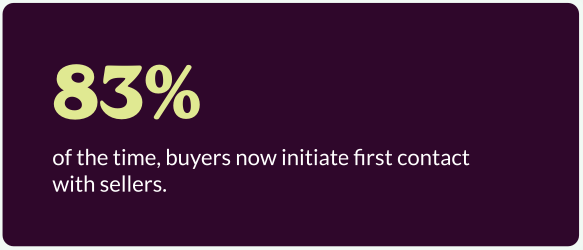
You can’t change the market. Sales and marketing noise is only going to increase. Tomorrow’s buyers will be even more independent. What matters is how you respond to these changes.
Sticking with traditional outbound sales will lock you in a cycle of skyrocketing spend and diminishing returns.
Some of the best salespeople look more like project managers than salespeople. They set the vision, hold people accountable, and execute against the agreed-upon plan.
This guide reveals how sales leaders are rebuilding their prospecting motion to match the way people buy. In fact, we’ve implemented this exact same framework at Salesloft. You’ll learn how we’re unifying inbound and outbound teams under a new allbound structure, rebuilding their prospecting motion, and driving results in a tough market.
The future of sales is "allbound"
The problem with old-school outbound isn’t just the results. The underlying idea is broken, too. Sure, traditional outbound is proactive and lets reps get after it, but it ignores a humbling fact: only 5% of your total addressable market is actively buying at any one time.
Allbound rethinks your investment.
It shifts your limited resources from a huge, unqualified market to a much smaller and profitable one by focusing on in-market accounts.
Here’s how it works.
New strategy, new structure
Allbound rebuilds your go-to-market motion, merging your previously separate inbound and outbound teams. The silos come down when your sales and business development representatives (XDRs) and your account executives (AEs) start working together.
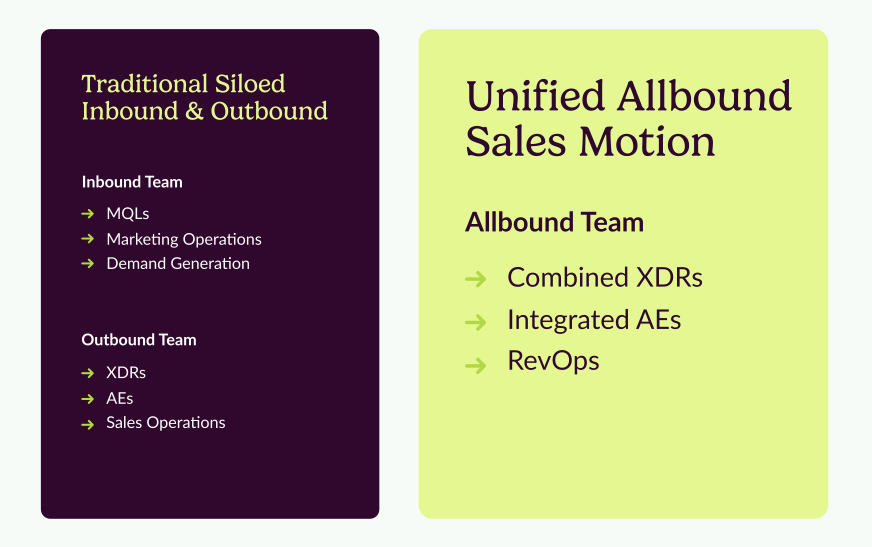
In this new structure, the XDR role changes — a lot.
Before, XDRs worked huge unqualified lists hoping to stumble across an active buyer. It was tremendously inefficient.
Allbound XDRs instead work from a list of target and inbound accounts. In other words, the people who actually want to buy. By crunching data and buying signals (or having AI do it — more on that later), XDRs can ruthlessly prioritize their time, focusing on accounts they know to be in-market.
The allbound AE role evolves, too.
In SMB and enterprise segments, allbound AEs receive all inbound demo requests. It’s fast, efficient, and allows them to specialize more effectively.
They’ll have to prospect, too. Today’s tighter economic outlook means everyone has to lean in.
XDRs are prospecting. AEs are prospecting. Even executives are prospecting.
Done poorly, having XDRs and AEs both outbounding creates friction. Old school AEs might see it as a demotion. And without effective coordination, they could stumble into live XDR conversions, too.
Successful allbound orgs acknowledge the risk and design their processes to mitigate it. Be crystal clear when dividing up tasks so XDRs and AEs know precisely what accounts they’re prospecting. That way, you reduce duplication and stop reps from stepping on each other’s toes.
When XDRs and AEs outbound together, they enjoy higher conversion rates than going at it alone.
Multichannel, omnichannel, allbound
Modern buyers are channel agnostic. They’ll contact you or engage with you however they feel like it. As Brent Adamson, former Distinguished VP at Gartner put it, "Sales reps are no longer the channel to customers, but simply a channel."
Allbound doesn’t just acknowledge this fact, but embraces it. It pushes your personalized sales messaging everywhere: on email, phone, social, third-party, and elsewhere. Prospects see the same pitch-perfect message wherever they are.
In this new model, sales owns some channels while marketing and customer success manage others. Allbound works best when it’s cross-functional and leaders across the organization are bought in on the transformation.
Rally behind revenue
Siloing inbound and outbound sellers naturally gave rise to siloed performance management strategies. Traditionally, XDRs were compensated on meetings booked.
Meetings are undeniably important, but they aren’t the end goal. Booking a thousand unqualified meetings won’t hit your quarterly targets. What really matters is revenue — cold hard cash hitting your company’s accounts.
Uniting sellers in an allbound strategy allows you to focus everyone on just that. That means compensating XDRs on deals that closed from their pipeline, not just for booking meetings.
Paying your team for meetings is a great way to get fired.
Zooming out, allbound gives you an opportunity to rethink all incentives and performance management, alongside improved individual compensation.
Take your enterprise’s overall business objectives and break them down into discrete sales goals. For example, if your company is trying to establish a European beachhead this financial year, include net-new EMEA logo acquisition in your team objectives.
Although cash and monetary rewards should form the backbone of your compensation strategy, sprinkle in non-monetary rewards, too — recognition, career development opportunities, charity donations, experiences, extra leave, and so on.
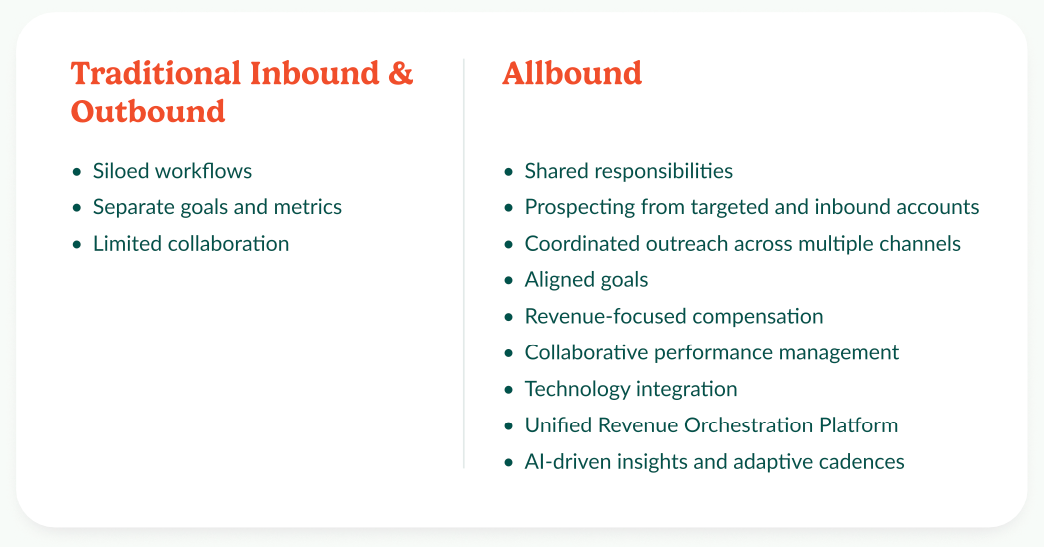
Meet the metrics that matter
A sales org without data is chaos. It's impossible to tell what cadences are generating pipeline, how you're trending towards your quarterly goals, or which sellers need extra coaching.
But you need the right metrics that allow you to identify insights and the best actions.
While specific metrics can vary from business to business, these are the metrics we’re using at Salesloft to help measure the performance of our allbound efforts.
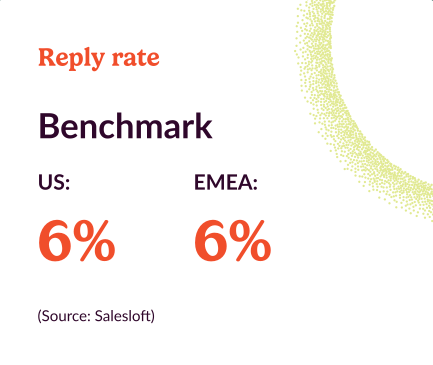
The sole purpose of a cadence is to get a reply — even if that reply reveals objections or a negative response.
However, you shouldn’t get blinkered when looking at reply rate data. As with any data point, you need the context of why something is, or isn’t, working.
Run cadence committees to analyze reply rates and evaluate the underlying templates and scripts. If you spot something that works, share that learning across your teams. Conversely, if something isn’t working, ensure none of your reps are making the same mistake.
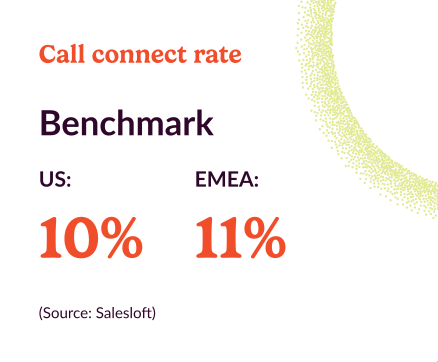
Sales is, and always will be, a challenge. No one sells without putting in a lot of activity. But reps hammering away on emails, phone, and social doesn’t guarantee success. Quality activity lands deals.
You measure that by tracking the connect rate or the number of attempts a rep takes to “connect” with their prospect. At Salesloft, we’re in a very crowded B2B SaaS market so we shoot for between 10–15% as our target.
Connect rate tracks reps’ effectiveness, verifying whether their activity is actually moving the dial.
If your reps or teams are sitting below the benchmark above, it’s time to look at what they’re doing.
Connect to meeting to opportunity
The end goal of any rep isn’t to connect with a buyer or book a meeting. It’s to book revenue.
These three metrics analyze your reps’ efficiency through the sales funnel so you know they’re getting the right outputs from their activity. If there’s a sudden drop in performance at one of the points, you can zoom in and see what’s wrong.
Your benchmarks might not match the industry average, but you need to set a baseline on these items and look to improve and monitor them as you go. Regularly assess these metrics to ensure consistent progression through the sales funnel and adjust strategies as necessary.
Contacts worked per account
Target: 5 contacts minimum for enterprise accounts.
Buying committees are expanding, causing slower sales cycles. These teams have now ballooned to just over nine people, on average.
When prospecting into an account, reps need enough depth (the number of contacts worked) and breadth (the quality of those relationships).
If reps are overly focused on the former, they’ll end up with a collection of very shallow relationships and no one will trust them enough to champion the deal and drive it forward.
Conversely, over-indexing on depth means they won’t get sign-off from crucial roles like the decision-maker and budget holder.
When starting to work an account, we start off with five contacts and add more as reps get more information.
Quantity of activity
Target: 100 activities minimum per day across email, phone, social, video, and other channels.
Think of it like this: keeping up a steady stream of activity means your reps are always on prospects' radar. By reaching out through different channels, you're making sure your message gets seen, no matter where they are.
This multi-channel approach isn't just about doing more. It's about being everywhere your prospects are, keeping your brand in their minds. Plus, it helps you figure out which channels work best for different types of outreach. With consistent engagement, you’re less likely to miss out on opportunities and keep your sales pipeline strong and lively.
Average touches per account
Target: 30 touches minimum per day across channels.
Account penetration is crucial. This varies greatly depending on your product and your ideal customer profile (ICP). Ensuring a sufficient number of touches per account helps in deeply engaging potential buyers and moving them down the funnel.
Consistent touches across multiple channels ensure that prospects remain aware and engaged, increasing the likelihood of conversion. Tailor your approach based on the specific needs and preferences of each account.
Unique accounts touched
Target: 5 unique accounts minimum per day across channels.
Breaking into new accounts is important as you work your buying group at target accounts. This metric ensures your reps are not just focusing on a few accounts but are actively expanding their reach and creating new opportunities.
Diversifying the accounts touched reduces the risk of over- reliance on a limited number of accounts. Encourage reps to explore new prospects regularly while maintaining relationships with existing ones.
Metrics made easy
Don’t be put off by a wall of new metrics. Modern metrics don’t need hours of tedious data collection. Instead, new sales tech consolidates all your XDR metrics on a single dashboard.
At a glance, you can see how each rep is performing across their goals in real-time. If you spot a trend or issue, you can act on it immediately.
Smart tech will surface insights and actions, too, like a call or email you should review. It ups your impact and ultimately lets reps book more revenue.
New Structures Need New Technology
Allbound probably couldn’t have existed even a few years ago. After all, how do you manually personalize at scale and coordinate pitch-perfect touches across every channel? You couldn’t. But AI has changed the game.
AI can help teams personalize messaging across dozens of channels. It can crunch through millions of signals to identify the best accounts, allowing reps to optimize their activity. It can refine your cadences and optimize your templates.
Here’s how AI technology is rebuilding the entire sales tech stack — in a single platform.
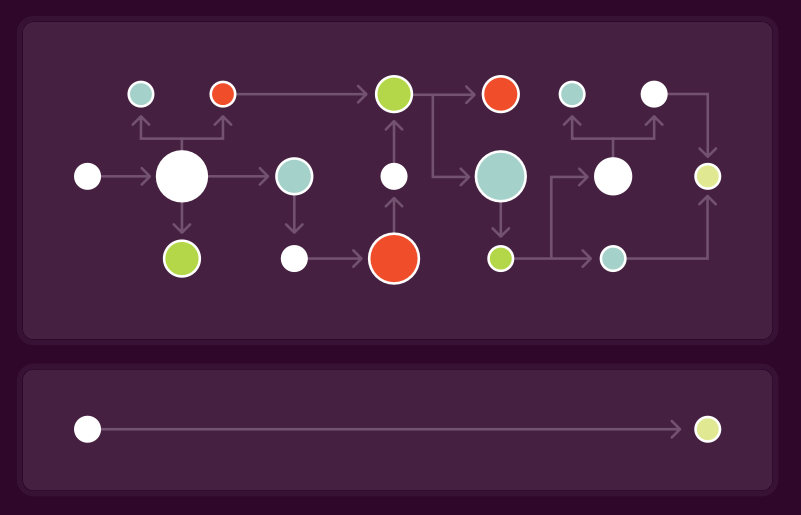
Unify your sales data
Old-school sales orgs rely on Frankenstein tech stacks. These disjointed systems stitch together dozens of “point solution” tools like standalone dialers, screen recorders, and schedulers. Reps have to jump from one to another, gleaning fragments of insights from each and mentally piecing them together. It’s taxing, tiring, and utterly inefficient.
A unified Revenue Orchestration Platform consolidates your functionality and data in one place. Sales data flows from one capability to the next, giving you a crystal clear picture of your prospects.
Reps work from a single pane of glass. No more endless context switching killing their motivation. Platforms crunch through your unified data sets and provide real-time insights and actions. For example, noticing that your AEs have insufficient pipeline coverage and assigning them time to prospect.
Reps, together with colleagues in marketing and customer success, can act faster, working together to drive deals towards the finish line.
Effective allbound depends on your team’s ability to roll up everything — buyer, seller, and opportunity data — into crystal clear dashboards. This puts the most important data at your managers’ and executives’ fingertips, empowering them to take proactive actions before deals are lost.
Test, refine, and improve
Make selling a science with A/B tests to identify your most effective approaches. Automate experiments across email subject lines, call scripts, and outreach sequences to highlight the most effective approaches.
Once you’ve surfaced the most effective messaging strategies, share them across your teams to turn individual successes into org-wide advantages.
Adapt cadences in real-time
A “set-and-forget” sales strategy is doomed to fail. Great reps are nimble and adaptive, responding to every new piece of information they learn about a prospect and account.
The problem is, doing that at scale is tough. Working even a dozen accounts can mean monitoring and maintaining hundreds of relationships with buyers.
Enter adaptive cadences.
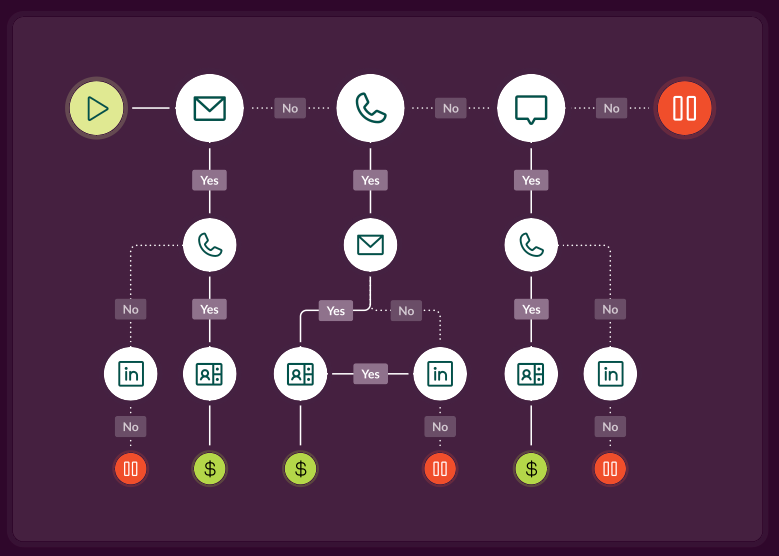
Unified revenue platforms consolidate your data. It then ingests every buyer signal to adjust your cadences in real time. Say a prospect is on your website every day reading case study content, your reps can take immediate action to ramp up engagement. Conversely, if a prospect’s engagement is waning, your reps can also adapt and diversify your touches across email, social, and phone.
Adaptive cadences keep your reps in the loop, too. Tap them for qualitative insights on what’s working and what needs to change. Combine that with quant performance data for a holistic evaluation.
Finally, diversify.
Modern B2B buyers don’t follow a simple sequential buying journey. They jump forward and evaluate potential suppliers, before doubling back and hammering out their problem statement.
Build a grab bag of cadence templates, each tailored to a specific stage of the buyer journey. Instead of railroading buyers down inflexible sequences, reps can deliver a pitch- perfect cadence that’s right for that moment.
Watch what triggers and signals are particularly effective and use those insights to improve your cadences. It’s evolution and improvement.
Connect with buyers — any time
Delayed responses can make or break deals. Buyers expect instant engagement while they’re actively researching your business. The problem is, reps aren’t instantly available 24/7.
This is where conversational marketing and AI-powered chatbots shine.
Chatbots are like an always-on sales assistant, ready to engage buyers the second they’re needed. They can monitor intent signals and proactively engage high-intent buyers when they hit your website.
They can recognize and enrich qualified leads. And they can personalize chat experiences to deliver a seamless customer experience and keep deals moving towards the finish line.
Augment your sellers
More than 80% of sales leaders believe AI will reduce time spent on manual tasks and allow their reps to focus on building relationships, opening up opportunities, and closing deals.
They're completely correct.
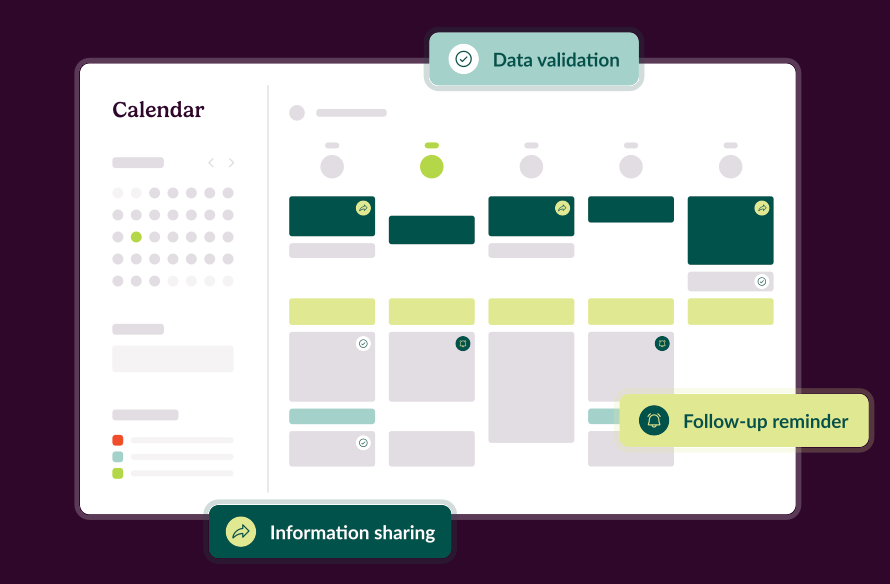
AI can reclaim two hours per day for reps by automating administrative work like data validation and information sharing. That’s like gifting your reps an extra day and change per week.
But AI can do far more than just handle the boring bits of sales.
AI can crunch through millions of sales data points to surface insights and uncover patterns that the human eye simply can’t spot like a previously ignored (but highly profitable) market segment or a simple cadence that’s still churning out results.
And because Revenue Orchestration Platforms unify everything in one system, those insights are available everywhere and to everyone — sales, marketing, customer success, product, engineering, whoever. Collaboration becomes easier and everyone wins.
Outbound, but better
Traditional outbound is evolving, but outbound itself isn’t going anywhere. It’s becoming part of a wider allbound strategy.
The future of sales lies in a joined-up prospecting strategy, where inbound and outbound teams collaborate to deliver a joyful buying experience from start to finish on whatever channel a prospect chooses to use.
As you’ve seen, the shift from siloed inbound and outbound requires big changes: new org design, fresh metrics, and innovative tech. But for enterprises willing to brave their transformation, the benefits are huge: happier reps, shorter deal cycles, bigger deal sizes, and faster growth.





























